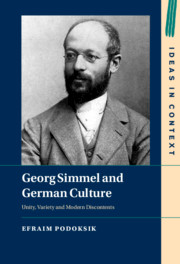Book contents
- Georg Simmel and German Culture
- Ideas in Context
- Georg Simmel and German Culture
- Copyright page
- Contents
- Acknowledgements
- Note on Translations and References
- Introduction
- Chapter 1 Bildung, Kultur, Crisis
- Chapter 2 Unity in Variety
- Chapter 3 Unity versus Variety
- Chapter 4 Unity above Variety
- Conclusion
- Bibliography
- Index
Chapter 3 - Unity versus Variety
Published online by Cambridge University Press: 07 July 2021
- Georg Simmel and German Culture
- Ideas in Context
- Georg Simmel and German Culture
- Copyright page
- Contents
- Acknowledgements
- Note on Translations and References
- Introduction
- Chapter 1 Bildung, Kultur, Crisis
- Chapter 2 Unity in Variety
- Chapter 3 Unity versus Variety
- Chapter 4 Unity above Variety
- Conclusion
- Bibliography
- Index
Summary
This chapter analyses Simmel’s intellectual explorations during his middle period (ca. 1900 – ca. 1910). Having despaired of the possibility of finding a grand synthesis, Simmel developed a radically pluralistic vision of the world, in which no comprehensive unity was envisioned, but each particular form of experience served as a symbol of unity. This view formed in his mind as he engaged with the ideas of Schopenhauer and Nietzsche. The chapter examines Simmel’s attempts to find a symbol of unity in the aesthetic and religious experience, as well as in the experience of femininity. These explorations, however, did not bring about any general philosophical solution. In the end, none of these experiences was shown by to be a fully satisfactory answer to the discontents of modernity.
- Type
- Chapter
- Information
- Georg Simmel and German CultureUnity, Variety and Modern Discontents, pp. 145 - 213Publisher: Cambridge University PressPrint publication year: 2021

